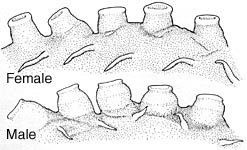Grimpoteuthis bathynectes
Richard E. Young and Michael VecchioneIntroduction
G. bathynectes is known from the 13 specimens reported in the type description. They were captured in bottom trawls during a study of the fauna of the continental slope and the Tufts and Cascadia Abyssal Plains.
Characteristics
- Arms and web
- Arms subequal, with arms IV generally shortest.
- Web formula, variable, usually ABCDE.
- Web on dorsal arm margin extends nearly to arm tip.
- Web nodule present on ventral margin of each arm near, at or nearly at the termination of the web.
- Suckers
- Dorsal arms with 47-58 suckers.
- Sucker arrangement: first 4-5 suckers small or minute, followed abruptly by larger suckers that increase in size over first third of arm length, then gradually decrease to tip.
- Sexual dimorphism in suckers: Males - largest sucker diameter 4.3-6.7% of ML, shape globular; females - largest sucker diameter 2.6 -3.5% of ML, shape tubular.
- Cirri short: length 0.7 - 1.5 x largest sucker diameter.
- First cirri between suckers 3 and 4.
- Shell
- "...U-shaped, formed of rounded-edged flat strip that tapers to a thin flat point distally."
- "Fin insertions long and form slight angle near base with rounded apex."
Comments
The above description is taken from Voss and Pearcy, 1990. More details of the description of G. bathynectes can be found here.
Among Pacific species, G. bathynectes differs from:
- G. abyssicola in having fewer suckers (58 vs 77; web nodule at sucker 26 vs 32-34), shorter cirri (1.5 vs 2.5 x largest sucker diam.), position of first cirri (3-4 vs 4-6), shell shape (lateral arm of shell not expanded vs lobelike), anterior salivary present vs absent.
- G. tuftsi in having sexual dimorphism in sucker shape, less elongate gills, shorter cirri, absence of enlarged suckers near web nodules and no radula (Voss and Pearcy, 1990).
- G. innominata in the lack of peculiar features of the shell and, possibly, a shorter gill (half-orange vs semi-sepioid).
- G. hippocrepium by no clear characters other than locality.
- G. meangensis by, apparently, the lack of large shoulder blades on the shell.
- G. pacifica in having more suckers (77 vs 52).
Distribution
G. bathynectes is known only from the Tufts and Cascadia Abyssal Plains in the North Pacific off Oregon. The type locality is 45°01.1'N, 135°12.0'W, 3932 m.
References
Voss, G. L. and W. G. Pearcy. 1990. Deep-water octopods (Mollusca: Cephalopoda) of the Northeastern Pacific. Proc. Calif. Acad. Sci. 47: 47-94.
Information on the Internet
- Video: Octopus Ballet. Interactive Ocean. University of Washington.
About This Page

University of Hawaii, Honolulu, HI, USA

National Museum of Natural History, Washington, D. C. , USA
Page copyright © 2016 and
 Page: Tree of Life
Grimpoteuthis bathynectes .
Authored by
Richard E. Young and Michael Vecchione.
The TEXT of this page is licensed under the
Creative Commons Attribution-NonCommercial License - Version 3.0. Note that images and other media
featured on this page are each governed by their own license, and they may or may not be available
for reuse. Click on an image or a media link to access the media data window, which provides the
relevant licensing information. For the general terms and conditions of ToL material reuse and
redistribution, please see the Tree of Life Copyright
Policies.
Page: Tree of Life
Grimpoteuthis bathynectes .
Authored by
Richard E. Young and Michael Vecchione.
The TEXT of this page is licensed under the
Creative Commons Attribution-NonCommercial License - Version 3.0. Note that images and other media
featured on this page are each governed by their own license, and they may or may not be available
for reuse. Click on an image or a media link to access the media data window, which provides the
relevant licensing information. For the general terms and conditions of ToL material reuse and
redistribution, please see the Tree of Life Copyright
Policies.
- First online 13 May 2003
Citing this page:
Young, Richard E. and Michael Vecchione. 2003. Grimpoteuthis bathynectes . Version 13 May 2003 (under construction). http://tolweb.org/Grimpoteuthis_bathynectes/20118/2003.05.13 in The Tree of Life Web Project, http://tolweb.org/












 Go to quick links
Go to quick search
Go to navigation for this section of the ToL site
Go to detailed links for the ToL site
Go to quick links
Go to quick search
Go to navigation for this section of the ToL site
Go to detailed links for the ToL site